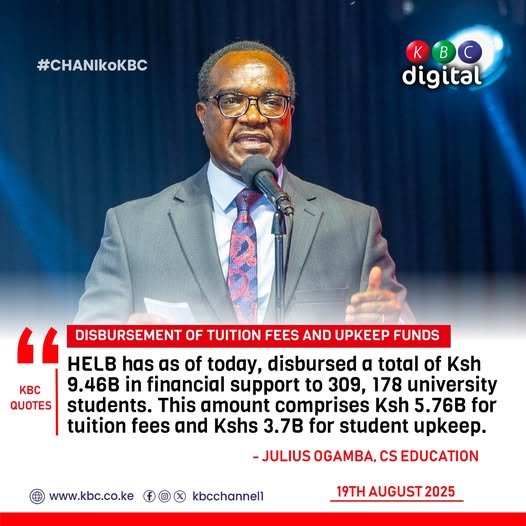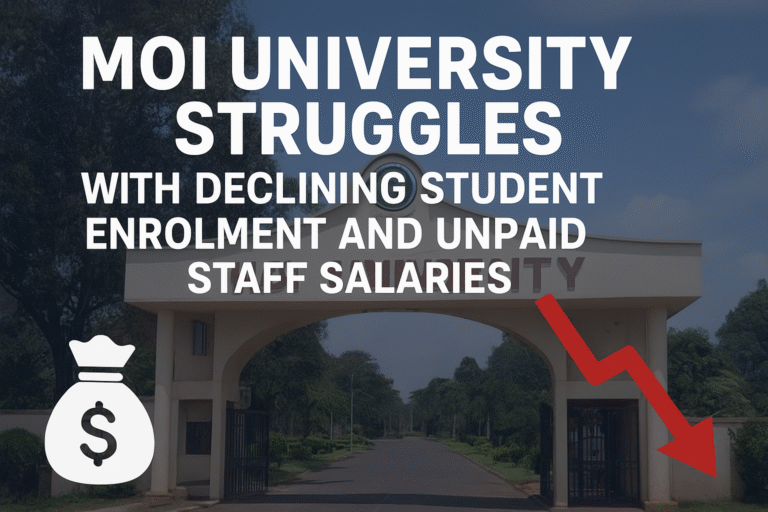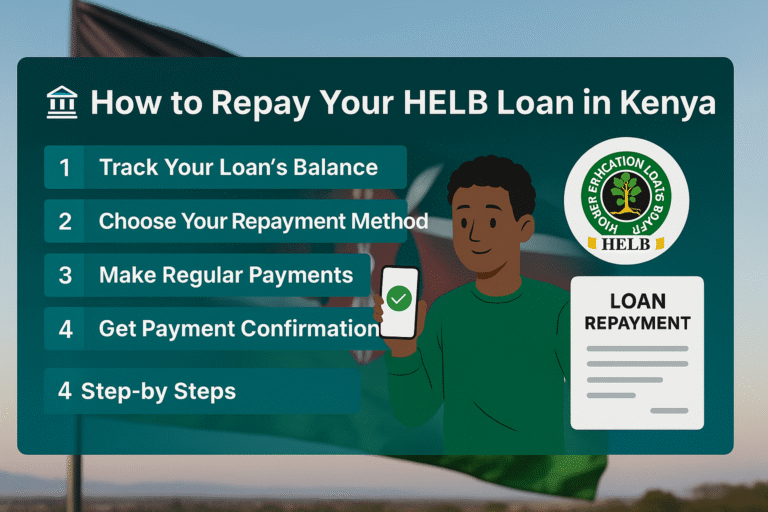In a bold and timely move to enhance access to higher education, the Government of Kenya has officially released Ksh 9.46 billion through the Higher Education Loans Board (HELB). The funds, aimed at supporting university students across the country, were announced by Education Cabinet Secretary Julius Migos Ogamba on August 19, 2025.
This disbursement is one of the largest in recent years and will benefit a total of 309,178 students. It comes at a critical moment when many families are facing financial pressure due to the rising cost of living. The funding reaffirms the government’s commitment to ensuring that higher education remains both affordable and accessible to all, regardless of background or income level.
“HELB has, as of today, disbursed a total of Ksh 9.46 billion in financial support to 309,178 university students. This amount comprises Ksh 5.76 billion for tuition fees and Ksh 3.7 billion for student upkeep,” stated CS Ogamba.
According to the Ministry of Education, the disbursed funds will help universities settle tuition payments while enabling students to afford accommodation, meals, transport, and other basic needs during the academic term.
CS Ogamba further urged students to log into their HELB portals to verify their loan status and confirm receipt of funds. He also reiterated the government’s long-term goal to make higher education funding more efficient, transparent, and student-centered under the revised New Funding Model (NFM).

Breakdown of the Ksh 9.46 Billion HELB Funds Disbursement
The total disbursement has been strategically split into two key segments to address both academic and personal needs of students:
- 📘 Ksh 5.76 billion has been directed toward tuition fees, which will go directly to universities and colleges. This ensures that learning institutions receive the funding needed to maintain operations and services.
- 💼 Ksh 3.7 billion has been allocated for student upkeep, directly deposited into student bank accounts to cover daily expenses like meals, housing, transportation, and other essentials.
This dual disbursement approach ensures that both universities and students benefit simultaneously, creating a more stable and supportive learning environment.
Who Will Benefit From the HELB Funds?
The latest HELB Funds disbursement targets university students across Kenya, with special emphasis on those from low-income and vulnerable backgrounds. The Ministry of Education confirmed that students enrolled in both public and private universities are eligible for the funds, provided they had applied through the HELB portal.
This move is expected to help thousands of learners who might otherwise struggle to afford tuition or living expenses, especially at the beginning of a new academic term.
How Students Can Confirm Receipt on the HELB Portal
To ensure transparency and help students stay updated, the Ministry of Education is advising all HELB beneficiaries to log in to the HELB portal and verify their disbursement status. This simple process allows students to confirm how much they’ve been awarded and whether the funds have been sent.
Here’s a step-by-step guide:
✅ Step 1: Visit the HELB Portal
Go to the official HELB website at www.helb.co.ke or directly to the student portal via student.helb.co.ke.
✅ Step 2: Log In to Your Account
Use your registered email or ID number and password to access your account. If you’ve forgotten your password, there’s an option to reset it.
✅ Step 3: Navigate to the Disbursement Section
Once logged in, look for options like:
- “Loan Status”
- “Loan Allocation”
These sections provide a full overview of your loan details.
✅ Step 4: Review Your Disbursement Information
You’ll see:
- Amount allocated for tuition (sent directly to your university)
- Upkeep funds (sent to your bank or mobile account)
- Disbursement dates and payment status
🔁 Stay Updated
Students are encouraged to check their portal regularly to:
- Confirm if the funds have reached their accounts
- Track changes or future disbursement schedules
- Get official announcements or messages from HELB
By doing this, students can avoid surprises and plan their academic expenses better and it also helps reduce confusion or fraud.

Statement by Education CS Julius Migos Ogamba
While addressing the media, Cabinet Secretary Julius Migos Ogamba emphasized the government’s unwavering dedication to supporting every Kenyan learner. He assured that no student would be left behind due to financial hardship.
“The Government will continue to provide the requisite funding to ensure that higher education remains accessible and affordable, and that no student is left behind on account of financial limitations,” CS Ogamba stated.
This public commitment reinforces the government’s efforts to promote equity in education, especially at a time when the cost of university education continues to rise.
Impact on Parents, Guardians, and Universities
For many Kenyan families, HELB funds act as a lifeline, bridging the gap between educational aspirations and economic challenges. The timely release of these funds significantly reduces the financial pressure on parents and guardians, who often struggle to raise tuition fees or daily upkeep for their children.
Universities, too, are major beneficiaries. With Ksh 5.76B being sent directly to institutions, schools can ensure continued access to academic services, improve campus facilities, and run smoothly without disruption caused by unpaid fees.
Importance of Upkeep Funds for Student Welfare
While tuition fees cover the cost of education itself, upkeep funds are equally essential they support a student’s daily life and survival while pursuing their studies. The government’s allocation of Ksh 3.7 billion toward upkeep in August 2025 ensures that learners can focus on their education without being overwhelmed by basic living expenses.
🔹 What Do Upkeep Funds Cover?
The upkeep portion of the HELB Funds is deposited directly into students’ personal bank accounts and is used to cover:
- 🍛 Daily Meals: Ensuring students have enough to eat throughout the term, which directly affects their concentration, health, and academic performance.
- 🏠 Accommodation: Helping students afford safe, stable housing either on or near campus.
- 🚌 Transport: Covering commuting costs to and from classes, especially for those living off-campus.
- 💻 Study Materials and Internet: Supporting access to books, stationery, digital tools, and connectivity, all crucial for modern learning.
- 💊 Health and Personal Care: Assisting with medical needs, hygiene products, and other personal essentials.
🔹 A Lifeline for Vulnerable Students
These funds are especially critical for students from low-income families or those studying far from home. Without upkeep support:
- Some may skip meals to save money.
- Others might live in unsafe or overcrowded spaces just to afford rent.
- Worst of all, many are forced to defer or drop out entirely due to financial hardship.
By providing these funds, the government is not just supporting education it’s protecting the dignity, safety, and future of Kenya’s youth.
Reaction from Education Analysts & Stakeholders
Education analysts have widely praised this move, calling it a timely intervention. They argue that investing in student funding is also an investment in Kenya’s future workforce.
Stakeholders in the higher education sector, including university administrators, have also expressed relief. In the past, delayed HELB patners Funds disbursements led to administrative and academic disruptions. With this release, many institutions can now operate without financial strain, ensuring a better learning environment for all.
Future of HELB Funding and the New Funding Model
The Ksh 9.46 billion disbursement made in August 2025 is not just a one-time relief it’s part of a larger government plan to reshape the way higher education is funded in Kenya. At the heart of this transformation is the New Funding Model (NFM), a strategy aimed at making HELB support more fair, efficient, and impactful.

🎯 What is the New Funding Model (NFM)?
Under the New Funding Model, HELB Funds no longer applies a one size fits all approach. Instead, support is now:
- ✅ Targeted – Funds are allocated based on the student’s actual level of need.
- ✅ Transparent – Students can easily track how much they’re eligible for and why.
- ✅ Needs-Based – Learners from disadvantaged or low-income backgrounds receive higher support compared to others.
This change ensures that the students who need help the most, receive it improving equity and fairness in education financing.
Government’s Long-Term Goals for HELB
To ensure HELB remains strong and relevant for years to come, the Ministry of Education has outlined three key goals:
🔁 Streamline the disbursement process
Faster and more accurate delivery of funds to reduce delays and student frustrations.
📈 Expand funding coverage
Bring in more students including those in TVETs, private universities, and marginalized regions to widen access to higher education.
🛡️ Ensure sustainability
Improve the loan recovery system, engage employers, and review policies to ensure that the HELB fund doesn’t run dry in the future.
💻 Digitization for Better Access
As part of modernization efforts, the government is also working to digitize HELB services, making the system more user-friendly and efficient. Some of the improvements include:
- Online loan applications with status updates
- Mobile notifications and bank integrations
- Easier communication and customer support through digital platforms
These efforts aim to reduce paperwork, eliminate long queues, and make HELB more accessible to students in every corner of Kenya.
Frequently Asked Questions
How can I check if my HELB loan has been disbursed?
You can check your disbursement status by logging into the HELB student portal. Once logged in, navigate to the “Loan Status” or “Loan Allocation” section to see your disbursement details, including tuition and upkeep breakdown.
When was the Ksh 9.46B HELB fund disbursed?
The official announcement was made on August 19, 2025, confirming that HELB funds were released in August 2025 to benefit over 309,000 university students across Kenya.
How is the HELB loan amount divided?
The Ksh 9.46 billion is divided as follows:
- Ksh 5.76B for tuition fees (paid directly to universities)
- Ksh 3.7B for student upkeep (sent directly to student accounts)
Who is eligible to receive HELB funds in August 2025?
University students who applied through the HELB portal and met the funding criteria are eligible. Both public and private university students are included in this disbursement.
What can I use the HELB upkeep funds for?
The upkeep funds are meant to cover essential living expenses such as:
- Meals and groceries
- Transport
- Accommodation
- Books and internet
- Personal care and health needs
What should I do if I haven’t received my HELB loan yet?
If your HELB loan hasn’t been reflected in your portal or bank account:
- Log in to your HELB portal to check for updates.
- Confirm that your loan status is “disbursed.”
- If there are issues, contact HELB support via phone, email, or social media channels
Conclusion
The release of Ksh 9.46 billion in HELB funds is a significant win for university students, their families, and Kenya’s education system as a whole. With over 300,000 students benefiting from both tuition and upkeep support, this disbursement reflects the government’s commitment to empowering the youth through education.
At a time when many are grappling with economic hardship, these funds ensure that students can stay in school, focus on their studies, and work towards a brighter future. As the Ministry continues to refine the New Funding Model, there’s renewed hope that no learner will be denied an education due to lack of funds.





